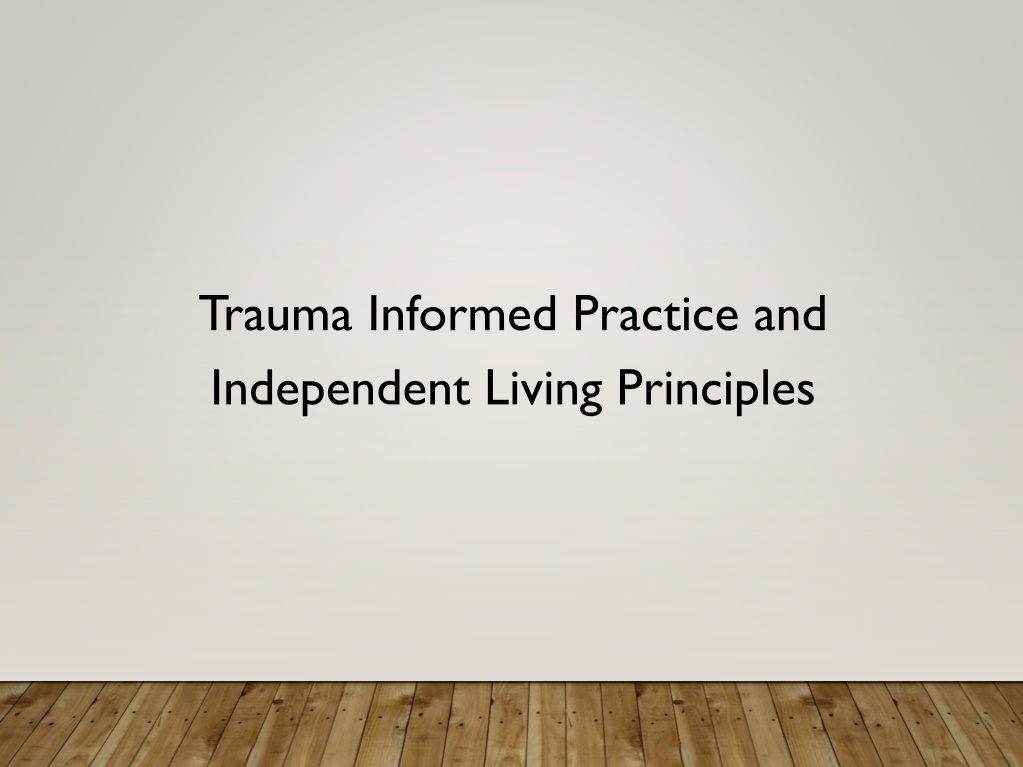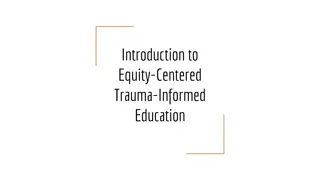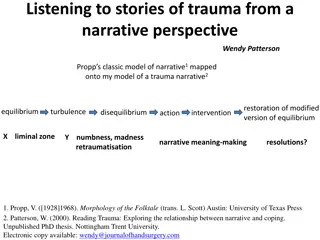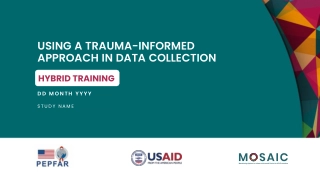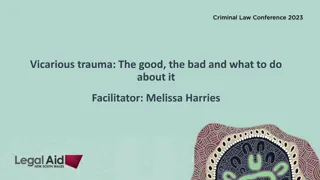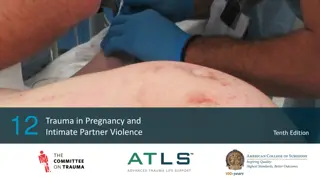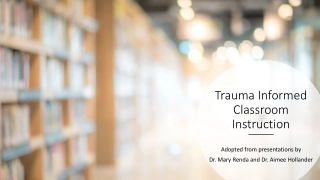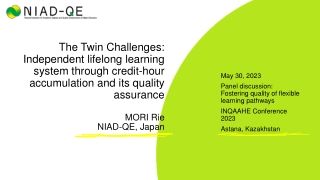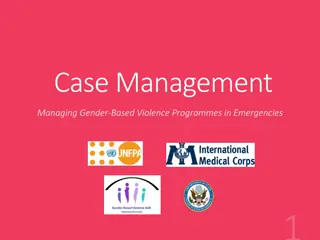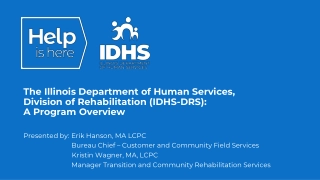Understanding Trauma-Informed Practice for Independent Living
Explore the dimensions and types of trauma, including single incident, complex, and developmental trauma, as well as intergenerational and historical trauma. Learn how coping patterns can be passed down through generations and discover the importance of Trauma-Informed Practice (TIP) to support individuals experiencing mental health concerns without re-traumatization.
Download Presentation
Please find below an Image/Link to download the presentation.
The content on the website is provided AS IS for your information and personal use only. It may not be sold, licensed, or shared on other websites without obtaining consent from the author. Download presentation by click this link. If you encounter any issues during the download, it is possible that the publisher has removed the file from their server.
Presentation Transcript
Trauma Informed Practice and Independent Living Principles
Overview of discussion Trauma definition Four Principles of TIP Intersectionality Socially Engineered Traumas
Trauma can be defined as experiences that overwhelm an individual's capacity to cope. There are a number of dimensions of trauma, including magnitude, complexity, frequency, duration, and whether it occurs from an interpersonal or external source. Next we will look at different types of trauma
Single incident trauma is related to an unexpected and overwhelming event such as an accident, natural disaster, a single episode of abuse or assault, sudden loss, or witnessing violence. Complex or repetitive trauma is related to ongoing abuse, domestic violence, war, ongoing betrayal, often involving being trapped emotionally and/or physically. Developmental trauma results from exposure to early ongoing or repetitive trauma (as infants, children and youth) involving neglect, abandonment, physical abuse or assault, sexual abuse or assault, emotional abuse, witnessing violence or death, and/or coercion or betrayal. This often occurs within the child s care giving system and interferes with healthy attachment and development.
Intergenerational trauma describes the psychological or emotional effects that can be experienced by people who live with trauma survivors. Coping and adaptation patterns developed in response to trauma can be passed from one generation to the next. Historical trauma is a cumulative emotional and psychological wounding over the lifespan and across generations emanating from massive group trauma. These collective traumas are inflicted by a subjugating, dominant population. Examples of historical trauma include genocide, colonialism (for example, Indian hospitals and residential schools), slavery and war. Intergenerational trauma is an aspect of historical trauma.
Various sources of trauma are often related to underlying issues for many of the mental health concerns our consumers are experiencing. We need a tool in our practice toolbox to ensure we do not re- traumatize the people we are working with. One tool we can use is a Trauma Informed Practice (TIP)
Principles of Trauma Informed Practice Trauma-informed Practice Project Team. (2013). Trauma-informed Practice Guide. Vancouver, BC: BC Provincial Mental Health and Substance Use Planning Council https://cewh.ca/wp-content/uploads/2012/05/2013_TIP-Guide.pdf 1. TRAUMA AWARENESS A trauma-informed approach begins with building awareness among staff and clients about the commonness of trauma experiences; how the impact of trauma can be central to one s development; the wide range of adaptations people make to cope and survive after trauma; and the relationship of trauma with substance use, physical health, and mental health concerns.
2. EMPHASIS ON SAFETY AND TRUSTWORTHINESS Physical, emotional, and cultural safety for clients is key to trauma-informed practice because trauma survivors often feel unsafe, are likely to have experienced abuse of power in important relationships, and may currently be in unsafe relationships or living situations. Safety and trustworthiness are established through such practices as welcoming intake procedures; adapting the physical space to be less threatening; providing clear information about the programming; ensuring informed consent
3. OPPORTUNITY FOR CHOICE, COLLABORATION, AND CONNECTION Trauma-informed services create safe environments that foster self-determination, dignity, and personal control for those receiving care. Practitioners try to communicate openly, equalize power imbalances in relationships, allow the expression of feelings without fear of judgment, provide choices as to treatment preferences, and work collaboratively with clients.
4. STRENGTHS BASED AND SKILL BUILDING Consumers in trauma-informed services are assisted to identify their strengths and to (further) develop resiliency and coping skills. Practitioners emphasize teaching and modeling skills for recognizing triggers, calming, centering, and staying present.
INTERSECTIONALITY Intersectionality is the acknowledgement that everyone has their own unique experiences of discrimination and oppression and we must consider everything and anything that can marginalise people gender, race, class, sexual orientation, physical ability, etc. First coined by Professor Kimberl Crenshaw back in 1989, intersectionality was added to the Oxford Dictionary in 2015 with its importance increasingly being recognized in the world of women s rights.
INTERSECTIONALITY RESOURCES Intersectionality Kimberly Crenshaw: https://www.youtube.com/watch?v=ViDtnfQ9FHc What is Intersectionality? Queer 101: https://www.youtube.com/watch?v=EXJ4Dbdm1ks Urgency of Intersectionality: https://www.ted.com/talks/kimberle_crenshaw_the_urgency_of_intersecti onality?language=en
SOCIALLY-ENGINEERED TRAUMAS Socially-engineered traumas (SET) are defined as traumatic events rooted in social forces of oppression and inequality. In the case of many of our consumers, ableism, discrimination, eugenics, and violence Other examples of SETs are racism, sexism, homophobia, xenophobia etc.
Having an understanding of SET, will help to ensure we address the personal or individual impacts of trauma and are also aware of the larger systems that cause trauma. For example, using TIP to explore individual trauma experiences and how the large systemic experiences influence and impact the trauma of consumers For more information about SET: Check out the article by Shaia et al. https://www.ssw.umaryland.edu/media/ssw/field- education/Shaia-Article.pdf
Thank you for watching this video If you have any questions, please reach out! Laura Hockman: laura@ilvernon.ca
